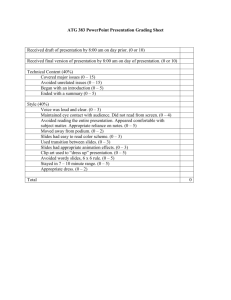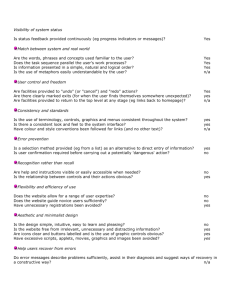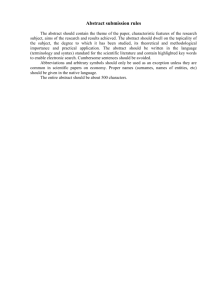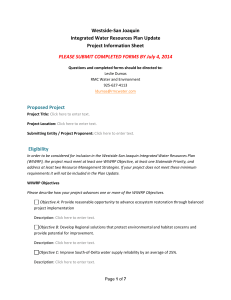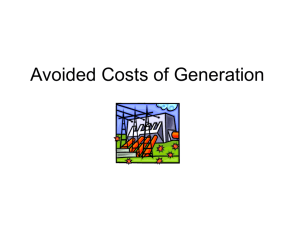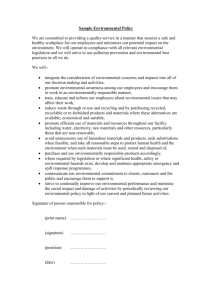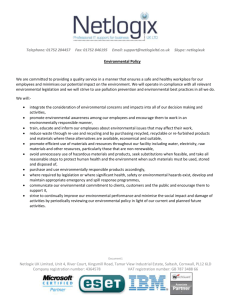here.
advertisement
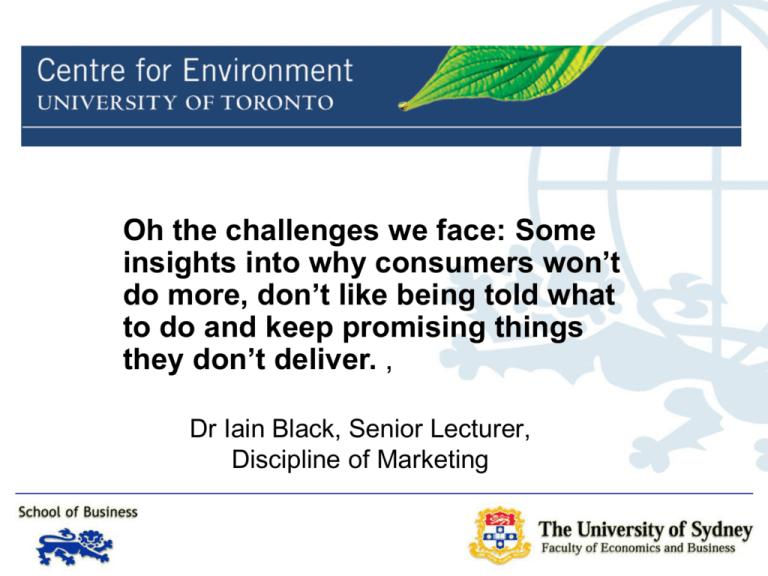
Centre for Environment Oh the challenges we face: Some insights into why consumers won’t do more, don’t like being told what to do and keep promising things they don’t deliver. , Dr Iain Black, Senior Lecturer, Discipline of Marketing Overview Overall problem Understanding the difficulty is getting consumers to adopt more sustainable forms of consumption Theoretical Perspective – Theory of Planned Behaviour Problems 1: Why consumers won’t do more – Study one: Identity boundaries Problem 2: How consumers react when you say no to them – Study 2: Self Identity and Involuntary loss Problem 3: Why consumers say one thing and do another – Study 3. Hyperbolic discounting vs Temporary Construal Theory. Theoretical Perspective Attitude-Behaviour disconnect is not new Theory of Planned Behaviour Problems 1: Why consumers won’t do more Becoming a more sustainable consumer Identity boundaries: Changing without changing too much. Research Aim and Objectives Research Aim: – To understand how global self concept is managed when a identity and set of behaviour are adopted Objectives: • • • • • To understand what has motivates people to adopt more environmentally sustainable consumption practices in their every day lives To understand the barriers placed around the adoption of this new lifestyle To illicit identity narratives of how their identity and self has changed as a more sustainable lifestyle has been adopted. To understand how has this adoption has been managed by other elements of identity and self To understand how behaviours and values that are incompatible with current identities are managed – Changed, modified rejected, adopted Conceptual Framework Definition of possessions – – – ‘Extended self’ (Belk, 1988) Tangible and intangible Characteristics: control, symbolic meaning, emotional attachment Managing self – Stability and transition • – Kleine et al. (1995) Past, present and future self • Markus and Nurius (1986); Morgan (1993) 1. Maintenance of self • Ahuvia (2005); Gentry et al. (1995); Levinson (1978); Prentice (1987) 2. Changes in self: separation, liminality, incorporation • Van Gennep (1960) Overview of Study Phenomenological perspective taken Sampling – Purposive, iterative “theoretical”. Data collection – In-depth interviews – Initial data collection: • Sydney 2007 • 18 men and women 30-45 years old • Attending basic conservation workshops and starting to adopt sustainable lifestyles • ACF GreenHome workshops • Data coded and analyzed – 2nd Phase: • Toronto 2008 • 6 women years old • Moved to sustainable lifestyle 3-5 years ago, behaviors are entrenched but critically having to adapt to new standards. Data analysis – Grounded theory techniques Findings New behaviour or standard Adopt Modify Postpone Resistance Dismiss Reject Conclusion Change possessions and chane use of these possessions without changing self concept Managing changes to maintain a coherent global self concept Continuous change rather than discontinuous change Respondents now incorporate may fairly radical conservation behaviors within definition of core identities as a mothers, wives, homemaker etc. Problem 2: How consumers react when you say “no” to them Study 2: Self Identity and Involuntary loss Who are you trying to fool? Consumers reactions to involuntary loss of possession. Voluntary disposition • Lastovicka and Fernandez (2005) • Disposition via garage sales showed that valance is important in whether disposal rituals are performed and detail types (Iconic Transfer, The Transition-Place Ritual, Ritual Cleansing) • Higie, Price and Fitzmaurice 1993 • Moving home • Price, Arnold and Curais, (2000) • Giving away by older consumer • Pavia (1993) and Kates (2001) • Disposition by PLWA Involuntary loss and self • This literature has taken as its focus a range of sudden or dramatic causes. • Loss due disasters such as fires or earthquakes (Delorme, Zinkhan & Hagan, 2004, Belk, 1988, Ikeuchi, Fujihara & Dohi, 1999) • Loss due to major traumatic life events such as: • Unemployment (McAlexander, 1991), • Divorce (Roberts, 1991), • Imprisonment (Brownlie & Horne, 1999) • Terminal illness (Kates, 2001). • Call made by a number of authors for research in this area i.e • Arnould and Thomson (2005) • Belk, Sherry, and Wallendorf's (1988). Investment rituals. Research question and context This research explores how consumers manage the situation and their self image when they are denied access (albeit temporarily) to symbolically important, meaningful possessions. It seeks to understand identity negotiation in situations where the loss is temporary and involuntary in nature. The context explored is premium class air travel and the associated frequent flyer programmes – Losses investigated • When an organisation will not pay for goods or services to which the employee has become attached and • Where the vendor withdraws the service due to insufficient loyalty. Methodology Interpretivist framework guiding research Multi method – Observation and Depth interviews (online/face to face) – – 2 Stages Stage 1: Participant observation involved three phases of travel and was sponsored by IBM. In total 110,000 miles were flown in a 10 month period. 50 flights were taken, – • • – 25 in economy and 25 in premium cabins. Example of route taken – – – SYD-LAX-SFO-NYC-LHR-MIL-LHR-SIN-SYD Business class Stage 2: Individual Depth interviews • • 26 IBM frequent flyers 6 Frequent flyers who have been downgraded in their FF programme Meaningful, Status filled possessions Premium class travel and high tier frequent flyer status confers status upon individuals, supports their career aspirations and differentiates them in a disconnected, anonymous world. Status is conferred not only when they were travelling but also when not travelling “and I get in the lift and I laugh and it is kind of nice but people have got their blue tag proudly displayed on their bag. (Mixed class traveller) “Business” travel brings respect from colleagues, friends and families. – Specifically in the work sphere Reasons? – high cost of premium class travel – reasons for travelling “must” be to attend to important matters. “What economy (class) tells me is that the company don’t value me or my time. I can be away negotiating hundred million dollar deals but I have to fly back economy, it’s embarrassing, and I hate doing it.” (Mixed class traveller) Motivation to maintain special treatment Maintaining possession using Illusion and Delusion Range of behaviours which show how travellers deal with the loss (or fear of its loss) of the service. – Stages of Mourning and Rebuilding (Delorme, Zinkhan & Hagen (2004), Illusion and delusion are used to maintain the pretence of possession in light of its loss. – Why not conduct mourning process? • Transient nature of the loss and the anonymity of the consumption • Therefore temporarily keeping up appearances until they are able to re-posses it. Findings Behavior and Objective Timeframe Threatened Happening Happening/Happened Objective Avert the loss Maintain public meaning Reconcile temporary state with desired state Actions o Achieving the goal by different means Refuse to travel based on socially acceptable arguments o o o Public meaning Private meaning Hedonic value Public meaning Private meaning Hedonic value Hedonic value (loss being reduced not avoided) Avoided Avoided o Primary losses being avoided o o o – Secondary losses being avoided Identity negotiation Avoided Acting the part Looking the part o Acts of reconciliation Transferring the loss Self denial Reconfiguring private meaning Moving happily Acting the part Maintaining a referent group and reward benefits. Examples from Observational phase: – On a number of occasions it was observed that flyers who subsequently travelled in the economy section would use business class check in queues despite the queue for economy being shorter – In another behaviour seen in both Sydney international airport and in London, economy travellers with high tier status would use the frequent flyers lounges for very short periods of time and walk considerable distances to do so. May also have been aimed at airline staff – Benefits of members extended to them, real or perceived. Looking the Part QFF Plat (OW Emerald,) QC Life, 97.75% to Lifetime Silver, NW Plat WPerks, SQ KrisFlyer, UA. SPG Gold, HHonors Gold, Hyatt GP, Avis Pref, Hertz No 1, et al However – He will not regain QFF platinum status – Closer examination memberships claimed on the signature line also show that not all is as it seems and it creates an illusion of ownership and status beyond that which is authentically possessed. – Duplications • (QFF Plat is equivalent to OW Emerald), – Apparently high tier status is in fact the entry level • (Hyatt GP (gold partner), Avis Pref-Avis (Preferred Customer ), – Some are given away to certain credit cards (HHonors gold) – Some are free to join and require no activity to maintain (SQ krisflyer, Hertz no one, UA). Findings Behavior and Objective Timeframe Threatened Happening Happening/Happened Objective Avert the loss Maintain public meaning Reconcile temporary state with desired state Actions oAchieving the goal by different means oRefuse to travel based on socially acceptable arguments oActing the part oLooking the part oActs of reconciliation Transferring the loss Self denial Reconfiguring private meaning oMoving happily Primary losses being avoided oPublic meaning oPrivate meaning oHedonic value Public meaning Private meaning Hedonic value Hedonic value (loss being reduced not avoided) Avoided Avoided – Secondary losses being avoided Identity negotiation Avoided Conclusions Uneconomic, irrational and desperate behaviours can be understood when we consider that it the Self that is being affected and protected Reducing the impact and regaining control are common themes in the behaviours seen Research provides a range of behaviours and tactics used to cope with the transition from “old” to “new” self due to involuntary loss. This is achieved by, where possible AVOIDING the transition – – In so doing provides details to the work by Delorme et al 2004 which illustrated the steps taken Also provides mirror of Lastovicka and Fernandez (2005) work on voluntary loss behaviours Previous work into involuntary loss and self-concept has highlighted the process that consumers go through in order to realign their extended self to reflect their new found situation. – I add to this literature by showing how people can compensate for the loss via creating the illusion that the consumer is still in possession, (if only in part). Discussion So how does this help us understand consumers and sustainability: – Loss or restrictions are coming or already here • Credit crunch Many of the attempts to avoid loss were based on consumption, (mileage runs, greater use of facilities) – Therefore must be careful that by managing loss we do not stimulate consumption elsewhere! – How • Provide periphery symbols of possession (owners clubs, loyalty schemes) • Actions to disengage possession from identity – Moved beyond it, moved pass it Problem 3: Why consumers say one thing and do another Cost and Rewards Overview Consumers who sincerely profess to be concerned about the environment nevertheless fail to purchase “green” products such as energy efficient light globes and home appliances for the simple reason that these products have higher prices than less environmentally responsible alternatives. This research tests two competing explanations for this phenomenon – hyperbolic discounting and temporal construal. Differences between these two explanations have important implications for the kinds of marketing strategies likely to induce consumers to purchase “green” products. Contrasting HDT with TCT Hyperbolic Discounting Theory (HDT) emphasises the timing of outcomes (i.e., immediate vs. delayed rewards and punishments) and makes no distinction between lower-order and higher-order outcomes. Temporal Construal Theory (TCT) emphasises the timing of decisions (i.e., decide now or later) and posits a discounting of lower-order outcomes and an appreciation of higher-order outcomes over time. Key Experimental Factors – – – Decision timing (now versus later) Outcome timing (immediate versus delayed) Outcome level (lower- versus higher-order) Potentially Interesting Contexts – – – – Credit card purchases of items when funds are lacking Adoption of relatively expensive but energy efficient products Financial planning for future retirement Preparing for a major individual assessment HDT vs. TCT Hyperbolic discounting (HD) posits that the future is discounted at a decreasing rate, minimizing the influence of future positive and negative outcomes on purchase decisions. Temporal construal (TC) asserts that future purchase decisions are evaluated in terms of abstract principles and global assessments of desirability, whereas immediate purchases are influenced by concrete outcomes and ease of implementation. The two theories make different predictions regarding the effects of expressing the benefits of using “green” products in terms of (a) rebates for future energy savings, (b) lower bills, (c) less energy used, and (d) less greenhouse gas emissions. HD, TCT and Energy Saving Products HD implies that consumers do not purchase energy saving products because the often higher price is an immediate loss whereas financial and non-financial benefits occur much further in the future. TCT implies that consumers do not purchase energy saving products because the often higher price influences lower-order construals involving the ease of implementation, whereas the financial, and especially, non-financial benefits, influence higher-order construals involving the desirability of the outcome. Immediate and Distant Future Consequences of Energy Saving Purchases Hhd: The effects of the price difference and the energy savings will be smaller for distant versus immediate future decisions, but the decrease will be more pronounced for the price difference compared to the energy savings. Htct: The effect of the price difference will be smaller for distant versus immediate future decisions, but the effect of the energy savings will be larger for distant versus immediate future decisions. Temporal Construal Theory (TCT) Distant Future Immediate Future Lower-Order Construals Concrete Complex Ease of implementation Contextualised Secondary or peripheral Subordinate Goal irrelevant Data-driven Higher-Order Construals Abstract Simple Desirability of outcome Decontextualised Primary or central Superordinate Goal relevant Theory-driven Method We will conduct a laboratory experiment that requires respondents to choose between two alternatives in the same product category. One alternative is more environmentally responsible than the other. The experiment will manipulate the following factors: Experimental factors: – – – – – Product category (batteries, light bulbs, refrigerators, washing machines). Environmental status (green versus regular). Price differential between the green and regular product. Size of the future gain. Timing of the decision (tomorrow versus one year from now). Price will be manipulated at two levels, with the higher price always associated with the environmentally responsible product. The future gain will be manipulated at 2 different levels, with the gain always associated with the environmentally responsible product. Sample: – Students between the ages of 18 and 24 Immediate and Distant Future Consequences of Energy Saving Purchases “Imagine that (it’s one year from now and) you are planning a shopping trip (for tomorrow), and you have two ‘blown out’ light bulbs at home that need to be replaced. Which of the following options would you be more likely to purchase?” Environmentally Friendly Option Pack of 4 long life light bulbs Costs ($7.50, $15.00) Use (6, 14) times less electricity than the incandescent bulbs Inexpensive Option Pack of 4 incandescent light bulbs Costs $2.50 Use (6, 14) times more electricity as the long life bulbs Conclusions When considering why the main stream of consumers have been slow to adopt environmentally friendly products. I find Oscams razor a useful heuristic to work by: – They are more expensive – They don’t work as well. A intriguing problem is why we say with great earnest that we intend to buy EF products or behave in a more sustainable way but we don’t Overview Problems 1: Why consumers won’t do more – Doing too much infringes their Identity boundaries, it risks asking them to become someone they are uncomfortable coming Problem 2: How consumers react when you say no to them – Making consumers do something they don’t want to do can lead to greater levels of consumption Problem 3: Why consumers say one thing and do another – Framing the gain and loss is critical if you want to sell the environmentally friendly (but more expensive version) and the key may be framing economic rahter than higher order benefits Recommendations Change the standards for core identities to incorporate more radical conservation behaviours rather than try to turn people into eco warriors, treehuggers, environmentalists… Thank you Questions? Comments?
